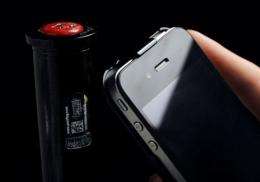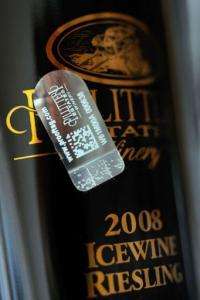Smartphones help world's winemakers foil fraudsters

For Charles Pillitteri, the fight against fraudsters began when he discovered fake bottles of his Canadian ice wine in Taiwan in 1998.
He tried everything to safeguard his product from counterfeiting, from 22-carat gold to invisible ink, only to realise that none would protect the consumer at point of purchase.
The proprietor of Pillitteri Estates Winery in Niagara-on-the-Lake, in the Canadian province of Ontario, found his solution in a bottle-top silver bubble seal that is impossible to copy.
"It gives us authenticity, traceability, integrity and customer satisfaction," said Pillitteri as the recent Vinexpo wine industry fair in Bordeaux.
The seals -- developed by Prooftag, a French firm that specialises in brand security -- is among several technologies that vintners are embracing to foil fraudsters and reassure consumers that they are buying the real thing.
With Prooftag, a consumer armed with an iPhone, a downloaded software application and Internet access can authenticate a wine in seconds, even while standing at the wine-store shelves.
"Its easy. You take your iPhone, take a shot of the datamatrix code and it takes you to the website and it shows you a picture of the bubble pattern for the bottle you are looking at," Pillitteri said.
"If you break the seal, all the bubbles are broken, the seal is gone and you cant copy it."
Android and BlackBerry versions of the app are due out by year's end.
Ice wine, a sweet dessert wine made from grapes frozen on the vine, is one of the most counterfeited wines in the world, particularly in Asia where it is a prestigious gift item.
"The bubble code creates a direct link between the final consumer and the brand holder and restores confidence," Clement Kaiser, chief executive of Prooftag, told AFP.

-- 'SpySeal is visible and invisible' --
Curiously, the bubble seal began as a failed product intended for the semi-conductor industry.
"We applied an adhesive, a polymer, and the fault appeared -- the bubbles," Kaiser told AFP. "The electrical properties were not consistent. We were not able to overcome the problem, so we stopped research for semi-conductors."
Exploiting the flaw, Prooftag sought ways in which its patented technology might prove useful -- and the wine industry, struggling with counterfeiting, was the answer.
Prooftag now sells bubble seals to winemakers in Canada, France, South America and the US state of California.
With Asian demand for Bordeaux wine growing, more and more of the region's estates are investing in bubble seals, Kaiser said, as well as other options that draw on smartphone technology.
The Bordeaux Wine Council took advantage of this year's Vinexpo to unveil an anti-fraud feature on its Smart Bordeaux application, which comprises a database of more than 8,200 Bordeaux labels in a dozen languages.
"For Smart Bordeaux, we began with the label so the consumer can see if the label even exists," said Christophe Chateau, a spokesman for the Bordeaux Wine Council, an industry group.
If con artists alter the name of a vintage slightly, say from Chateau Lafite to a whimsical "Chatreal Lafiteau", he said, a Chinese consumer may not discern the difference -- unless he can check the label against the database.
The Smart Bordeaux app has been downloaded more than 10,000 times already, with Chinese, Japanese and South Koreas accounting for a quarter of those.
Another option for beating the fraudsters is SpySeal, produced by another French company, Advanced Track and Trace, a trademark protection specialist based outside Paris.
"SpySeal is both visible and invisible," said ATT project manager Eric Dardaine.
The visible sticker has a datamatrix code that can be scanned with a smartphone, which then links to an Internet site -- but it also includes secret invisible indicators of tampering or fraud.
(c) 2011 AFP


















